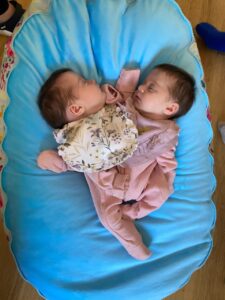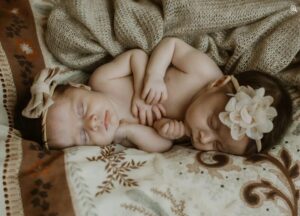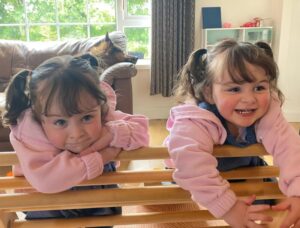Annabelle and Isabelle Bateson were born under extraordinary circumstances. The twin sisters came into the world in March 2022 fused from the chest down to the pelvis, sharing a liver, intestines, bladder, and even other vital organs. To make their situation even more complicated, the girls had only three legs between them—each had one leg of her own, while another was fused between their tiny bodies. From the very beginning, doctors knew that if the girls were to have a chance at living separate lives, they would need a highly complex surgical procedure, though no one could be sure if it would be possible or safe.

For the Bateson family in Northern Ireland, the pregnancy had already been a long-awaited miracle. After years of fertility treatments and waiting, the parents’ dream of having children finally came true. When doctors announced that they were expecting twin girls, the joy was overwhelming. But during routine scans, the happiness was quickly mixed with fear. Specialists explained that the babies were conjoined twins, a condition so rare and complicated that the future was uncertain. On the ultrasound screen, the expectant mother could clearly see two hearts beating side by side, but both belonged to daughters who were physically connected in a way that defied nature.
Immediately after their birth at University College Hospital in London, Annabelle and Isabelle were transferred to one of the UK’s leading children’s hospitals. A team of specialists quickly began the difficult task of preparing for a separation surgery. The months that followed were filled with meticulous planning and endless discussions. Doctors studied medical scans in detail, created 3D models of the girls’ organs and blood vessels, and even practiced on virtual simulations to anticipate every possible complication. Their goal was not only to separate the sisters but also to ensure that both would be able to live and grow independently after the operation.

By September 2022, the day everyone both feared and hoped for finally arrived. More than thirty doctors, surgeons, anesthesiologists, and nurses gathered in adjoining operating rooms. The procedure would be long and exhausting, and the outcome uncertain. Over the course of eighteen hours, the medical team worked tirelessly, carefully dividing the organs the girls had shared since birth. Piece by piece, the surgery progressed until, for the very first time, Annabelle and Isabelle were laid on separate operating tables. They still each had only one leg, but both had survived. Against overwhelming odds, the separation had been successful.
The weeks after the surgery were filled with challenges. Both girls remained in intensive care, undergoing constant monitoring and enduring dozens of dressing changes. Since their birth, they have undergone around twenty medical procedures, including additional surgeries to support their recovery and development. Yet despite the pain and the struggles, the girls grew stronger with each passing day. Doctors introduced them to physiotherapy, helping them learn to balance and move with the support of orthoses, and preparing them for the prosthetic limbs they will one day use.

Now, three years later, Annabelle and Isabelle are thriving. They are no longer defined by the condition they were born with but by their bright personalities and growing independence. Annabelle has blossomed into a lively and talkative child who loves to sing and enjoys being the center of attention. Isabelle, on the other hand, is calmer, more reserved, but also energetic and determined in her own quiet way. Together, they are growing up like ordinary sisters, with their own quirks, dreams, and personalities.

The story of the Bateson twins is one of hope, resilience, and modern medical achievement. What once seemed impossible has now become reality: two little girls who began life fused together are now living as individuals, supported by the love of their family and the dedication of doctors who refused to give up. Their journey is still ongoing, with physiotherapy sessions, orthoses, and preparations for prosthetics, but they are living proof that miracles can happen.


